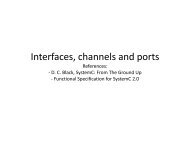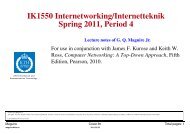An Overview of the PKCS Standards
An Overview of the PKCS Standards
An Overview of the PKCS Standards
Create successful ePaper yourself
Turn your PDF publications into a flip-book with our unique Google optimized e-Paper software.
Page 4<br />
ERROR! STYLE NOT DEFINED.<br />
2.2 Secret-key cryptography<br />
Secret-key cryptography is <strong>the</strong> technology in which encryption and decryption involve <strong>the</strong><br />
same key, a secret key. Pairs <strong>of</strong> users share a secret key, keeping <strong>the</strong> key to <strong>the</strong>mselves.<br />
Data encrypted with a secret key can be decrypted only with <strong>the</strong> same secret key.<br />
A secret-key algorithm is an algorithm for encrypting or decrypting data with a secret key.<br />
A secret key is typically used to encrypt <strong>the</strong> content <strong>of</strong> a message; in such an application,<br />
<strong>the</strong> key is called a content-encryption key and <strong>the</strong> secret-key algorithm is called a contentencryption<br />
algorithm.<br />
A password-based encryption algorithm is a secret-key algorithm in which <strong>the</strong> key is<br />
derived from a user-supplied password.<br />
The Data Encryption Standard (DES) is <strong>the</strong> standard federal secret-key algorithm,<br />
described in FIPS PUB 46–1. Cipher-Block Chaining (CBC) is a mode <strong>of</strong> DES, described<br />
in FIPS PUB 81.<br />
2.3 Message-digest algorithms<br />
A message-digest algorithm is a method <strong>of</strong> reducing a message <strong>of</strong> any length to a string <strong>of</strong><br />
a fixed length, called <strong>the</strong> message digest, in such a way that it is computationally infeasible<br />
to find a collision (two messages with <strong>the</strong> same message digest) or to find a message with<br />
a given, predetermined message digest.<br />
MD2 and MD5 are message-digest algorithms invented by RSA Laboratories, and are<br />
described in RFCs 1319 and 1321. Each inputs an arbitrary message and outputs a 128-bit<br />
message digest.<br />
3. What needs to be standardized?<br />
This section addresses <strong>the</strong> question, "What needs to be standardized?" To answer <strong>the</strong><br />
question, we describe four applications <strong>of</strong> public-key cryptography: digital signature,<br />
digital enveloping, digital certification, and key agreement, looking at what aspects are<br />
suitable for standardization. Our emphasis is on those applications relevant to <strong>PKCS</strong>; <strong>the</strong>re<br />
are certainly o<strong>the</strong>r applications, such as interactive au<strong>the</strong>ntication, that could be<br />
standardized.<br />
The discussion <strong>of</strong> what needs to be standardized assumes two independent levels <strong>of</strong><br />
abstraction. The first level is message syntax, and <strong>the</strong> second level is specific algorithms.<br />
The intention is that message syntax and specific algorithms should be orthogonal. For<br />
example, a standard for <strong>the</strong> syntax <strong>of</strong> digitally signed messages should be able to work<br />
with any public-key algorithm, not just RSA; and a standard for RSA should be applicable<br />
to many different message syntax standards.

















